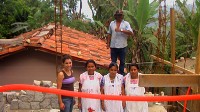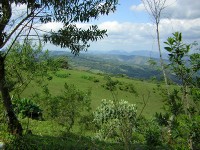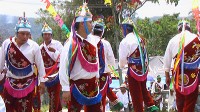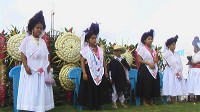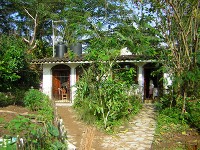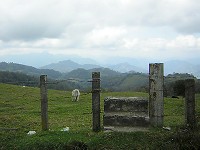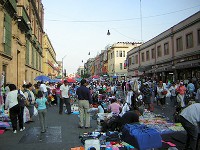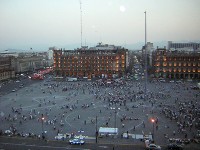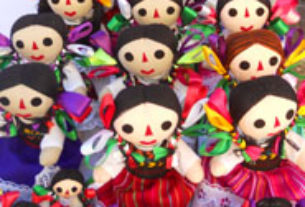Mexico is a land of contrasts; I see this in both of my workplaces.
Graffitied walls and worn picket fences; towering store signs and grazing cows; littered highways and rolling green hills – all of these images equally contradictory and impossible to imagine side by side. Yet, somehow these scenes are all strung together by a one-lane stretch of highway from Mexico City to the Sierra Norte Mountains of Puebla. The Sierra Norte occupies the northeastern part of the state of Puebla, about a three-hour drive from the city of Puebla.
Often the reality of the connection of these landscapes is not fully realized, as many experience the transition between urban and rural settings within Mexico gradually; there is an intermediate stop along the way, or the transition is so harsh that instead of focused awe it begets mindless staring out of a car or bus window. Over time, however, the magnitude of this contrast sinks much deeper than the landscape and one realizes that crumbling high-rises and thatched shanties also represent different ways of life.
This complex and shocking transition is one I have experienced every week for the past seven months. As a Fulbright scholar, the two-fold nature of my research project keeps one foot firmly planted in each place – the chaotic sprawl of Mexico City and the fog-bathed mountains of the cloud forest in the Sierra Norte of Puebla.
As my trips back and forth from the Sierra have grown increasingly frequent, I have realized that the change along the side of the road does not simply signify a shift in landscape, but a conversion of self. My Mexico City self is a student in the graduate program in Latin American Studies at the Universidad Nacional Autónoma de México who enjoys running in Parque México, street markets, and going out to lunch with friends in La Condesa. By stark contrast, my Sierra-self spends days living out of backpack, interviewing and working alongside members of a cooperative of indigenous Nahua women in a community called Yohualichan, which lies eight kilometers outside of the small colonial town of Cuetzalan.
In Yohualichan, the women come to work each day rain or shine, sometimes walking distances of forty minutes or more, to watch the store selling their artisan work or serve as cooks in the restaurant that serves traditional indigenous recipes. Interviews with many of the women have revealed just how many challenges to success they face in their business and personal lives.
In the late 1980s, they were thrown out of their meeting place in the town center by a new auxiliary president and robbed of a mill, sewing machines, and other donated machinery. Years later, they lost one of their founding members and hardest workers. They continuously fight to renew the value of the hand-woven and embroidered textile artisan goods they produce by focusing on quality and selling at just prices. Almost all have sick family members whose illnesses either remain concealed, misdiagnosed, or untreated due to lack of resources – or they are sick themselves. Despite these harsh realities, they continue to work toward educating the local community and beyond about the value of artisan work as a means of preserving cultural heritage.
It is seeing and living among these realities that leaves me unsettled in many ways. While there, I am there to help but ultimately at the end of the day I am also the one who goes back to a completely different life in the city, free of the severe struggles faced by many of these women. Many of them struggle to give the best care to their sick relatives, feed their families enough, and fight discrimination as working women within a community where their position as leaders and business people is not always accepted. Given my highly contrasting experiences, the question I pose to myself then becomes: how can I reconcile these two exceedingly different and seemingly opposed selves?
I have found that the answer to this question is not completely internal, that is to say, finding my own personal way of coping. Rather, the answer lies in reflecting, yes, but also in coming to terms with the nature of Mexico as a nation.
Mexico is a land of contrasts; I see this in both of my workplaces. In Yohualichan I arrive to work on a converted pickup truck that functions as a bus. There I spend the day conducting interviews and piecing together information that is being transformed into a narrative history of the cooperative’s twenty-year existence. The goal behind this project is to capture the events, difficulties, and successes of the group’s efforts to preserve their culture – to chronicle events that right now are only preserved in memory. It will also be a source that textually recognizes the hardships of this endeavor and the oppressive cultural norms they have left behind.
Most group members would say that their ultimate goal is to achieve gender equity in the workplace: a sense of co-responsibility among women and men in the community to work together to conserve the dress, artisan work, cuisine, and way of life of their ancestors.
By contrast, my trek to school in Mexico City begins in a packed, steaming car of the metro going toward Universidad. As I coil myself in among the other women riding in the segregated first few cars, I marvel at how overwhelming and frightening this scene would be to the women in Yohualichan. An afterthought quickly follows, though, and I cannot help but wonder if the work of indigenous women in a rural community is completely divergent from the desires of the masses in Mexico City.
If the goals of a rural micro-business are to conserve cultural heritage and promote gender equity in a community that maintains rigid gender divisions, then is this not in some sense a similar goal of people like me riding the subway in the city? I find myself thinking that the separate but equal facilities like this that conjure connotations of a post-slavery segregated South and living amid hunger, homelessness, and other symptoms of poverty is not what we desire as citizens of the city either.
Thus, while my urban life seems at times diametrically opposed to my rural life as a researcher, such acute judgments cannot be taken completely for truth. This is applicable to all of us who experience the overwhelming richness and simultaneous deficiencies of Mexico. Given the severe contrasting nature of landscapes in Mexico, it is inevitable that this sense of rupture translates into a fractured sense of self. However, I have come to believe that having this awareness is infinitely more valuable than living blind and insensitive to it. As conscious people, our thoughts can be moved into action. Therefore, rather than stew in a false sense of guilt, we must realize that by contributing to whatever landscape, community, and group we are a part of – whether in the city or the country – we are helping it to be realized, in whatever small way, as a better, more just version of itself. That, if nothing else, my experience as a student-research in Mexico has taught me.


